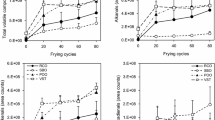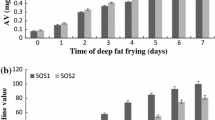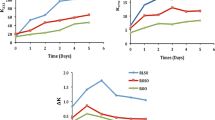Abstract
The main objective of this study was to determine the effect of different frying oils and frying methods on the formation of trans fatty acids and the oxidative stability of oils. Sunflower, canola and commercial frying oils, the most commonly used oils for frying potatoes in the fast food industry, were used as the frying medium. The value for total polar compounds was highest when commercial frying oil was used in the microwave oven (22.5 ± 1.1). The peroxide value, as an indicator of oil oxidation, was lowest for microwave oven frying (2.53 ± 0.03). The K232 and K270 values were 0.41 ± 0.04 and 0.18 ± 0.02, respectively, for commercial frying oil in the microwave oven. The lowest free fatty acid content was recorded for the commercial frying oil used in the deep-fat fryer at 190 °C. The highest iodine value was measured for sunflower oil used in the deep-fat fryer (148.14 ± 0.07), indicating a greater degree of unsaturation. The lowest trans fatty acid value was recorded for sunflower oil in the microwave oven (0.17 ± 0.05), with a higher overall amount of total trans fatty acids observed for oils after frying in the electrical deep-fat fryer compared to the microwave. Sunflower oil was favourable for both frying methods in terms of the trans fatty acid content.




Similar content being viewed by others
References
Mozaffarian D, Katan MB, Ascherio A, Stampfer MJ, Willett WC (2006) trans Fatty acids and cardiovascular disease. New Eng J Med 354:1601–1613
Oomen CM, Ocke MC, Feskens EJM, Erp-Baart MJ, Kok FJ, Kromhout D (2001) Association between trans fatty acid intake and 10-year risk of coronary heart disease in the Zutphen Elderly Study: a prospective population-based study. Lancet 357:746–751
Kim SH, Chunawala L, Linde R, Reaven GM (2006) Comparison of the 1997 and 2003 American Diabetes Association classification of impaired fasting glucose: impact on prevalence of impaired fasting glucose, coronary heart disease risk factors, and coronary heart disease in a community-based medical practice. J Am Coll Cardiol 48:293–297
Kohlmeier L (1997) trans-fatty acids and breast cancer. Food and Chem Toxicol 35:1228–1234
Albuquerque TG, Costa HS, Castilho MC, Sanches-Silva A (2010) Trends in the analytical methods for the determination of trans fatty acids content in foods. Trends in Food Sci Technol 22(10):543–560
Khor GL, Esa NM (2008) trans Fatty acids intake: epidemiology and health implications. In: Dijkstra AJ, Hamilton RJ, Hamm W (eds) Trans fatty acids. Blackwell Publishing, Oxford, pp 25–45
Grandgirard A, Sebedio JL, Fluery J (1984) Geometrical isomerization of linolenic acid during heat treatment of vegetable oils. J Am Oil Chem Soc 61(10):1563–1568
Moreno M, Olivares DM, Lopez FJA, Adelantado JVG, Reig FB (1999) Determination of unsaturation grade and trans isomers generated during thermal oxidation of edible oils and fats by FTIR. J Mol Struc 482–483:551–556
Bansal G, Zhou WB, Tan TW, Neo FL, Hl Lo (2009) Analysis of trans fatty acids in deep frying oils by three different approaches. Food Chem 116:535–541
Albuguerque TG, Sanches-Silva A, Santos L, Costa HS (2011) An update on potato crisps content of moisture, fat, salt and fatty acids (including trans-fatty acids) with special emphasis on new oils/fats used for frying. Int J Food Sci and Nutrition 63(6):713–717
Janoszka B, Blaszczyk U, Damasiewicz-Bodzek A, Sajewicz M (2009) Analysis of heterocyclic amines (HAs) in pan-fried pork meat and its gravy by liquid chromatography with diode array detection. Food Chem 113:1188–1196
Albuguerque TG, Oliveria MBPP, Sanches-Silva A, Bento AC, Costa HS (2016) The impact of cooking methods on the nutritional quality and safety of chicken breaded nuggets. Food Funct 7:2736–2746
Ziaiifar AM, Courtois F, Trystram G (2010) Porosity development and its affect on oil uptake during frying process. J Food Process Eng 33(2):191–212
Ahromrit A, Nema PK (2010) Heat and mass transfer in deep-frying of pumpkin, Sweet potato and taro. J Food Sci and Technol 47:632–637
Dincer I (1996) Modelling for heat and mass transfer parameters in deep-frying of products. Heat Mass Transf 32:109–113
Ni H, Datta AK (1999) Moisture, oil and energy transport during deep-fat frying of food materials. Food Bioprod Process 77:194–204
Chatzilazarou A, Gortzi O, Lalas S, Zoidis E, Tsaknis J (2006) Physicochemical changes of olive oil and selected vegetable oils during frying. J Food Lipids 13:27–35
Kalogianni EP, Karastogiannidou C, Karapantsios TD (2010) Affect of potato presence on the degradation of extra virgin olive oil during frying. Int J Food Sci Technol 45:765–775
Rojo JA, Perkins EG (1987) Cyclic fatty acid monomer formation in frying fats. 1. Determination and structural study. J Am Oil Chem Soc 64:414–421
Gertz C (2000) Chemical and physical parameters as quality indicators of used frying fats. Eur J Lipid Sci Tech 102(8–9):566–572
Barutcu I, Sahin S, Sumnu G (2009) Acrylamide formation in different batter formulations during microwave frying. LWT-Food Sci and Technol 42:17–22
Oztop MH, Sahin S, Sumnu G (2007) Optimization of microwave frying of potato slices by using Taguchi Technique. J Food Eng 79:83–91
Sahin S, Sumnu G, Oztop MH (2007) Affect of osmotic pretreatment and microwave frying on acrylamide formation in potato strips. J Sci Food Agri 87(15):2830–2836
Buffler C (1993) Microwave cooking and processing: Engineering fundamentals for the food scienti. AVI Book, New York, pp 6–7 150–151
AOAC (1984) Association of Official Analytical Chemists, 14th edn. AOAC Press, Washington
AOCS (2003) Official methods and recommended practices of the American Oil Chemists’ Society. AOCS Press, Champaign
Anonymous (1987) Standard methods for analysis of oils, fats and derivatives, 7th edn. Blackwell Scientific, Oxford IUPAC Method 2.301
Baltacioglu C, Esin A (2012) Chips production from Jerusalem artichoke (Helianthus tuberosus L.). Food and Nutri Sci 3:131–1328
Pedreschi F, Moyano P (2005) Affect of pre-drying on texture and oil uptake of potato strips. LWT-Food Sci Technol 38(6):599–604
Baik OK, Mittal GS (2003) Kinetics of tofu color changes during deep fat frying. Lebenmittel Wiss Und Technoogie 36:43–48
Pedreschi F, Moyano P, Kaack K, Granby K (2005) Color changes and acrylamide formation in fried potato slices. Food Res Int 38(1):1–9
Krokida MK, Oreopoulou V, Maroulis ZB (2000) Water loss and oil uptake as a function of frying time. J Food Eng 44(1):39–46
Southern CR, Chen XD, Farid MM, Howard B, Eyres L (2000) Determining internal oil uptake and water content of fried thin potato crisps. Food and Bioprod Process 78(C3):119–125
Guillen MD, Uriarte PS (2012) Simultaneous control of the evolution of the percentage in weight of polar compounds, iodine value, acyl groups proportions and aldehydes concentrations in sunflower oil submitted to frying temperature in an industrial fryer. Food Control 24:50–56
Firestone D, Stier RF, Bluementhal MM (1991) Regulation of frying fats and oils. Food Technol 45:90–94
Wai TNK (2007) Local repeatedly–used deep fat frying oils are generally safe. Int E-J Sci Med Educ 1(2):55–60
TCS (2010) Turkish codex standards. Notification of edible oils that mention plant name. http://www.kkgm.gov.tr/TGK/Teblig/2001-29.html (13 April 2016)
Gunstone FD (2008) Oils and fats in food industry Chapter 8, 1st edn. Wiley Blackwell, Hoboken
Sulieman AERM, Makhzangy AE, Ramadan MF (2006) Antiradical performance and physicochemical characteristics of vegetable oils upon frying of french fries: a preliminary comparative. J Food Eng 30:389–403
Urbancic S, Kolar MH, Dimitrijevic D, Demsar L, Vidrih R (2014) Stabilisation of sunflower oil and reduction of acrylamide formation of potato with rosemary extract during fat frying. Food Sci and Technol 57:671–678
Naz S, Siddiqi R, Sheikh H, Sayeed SA (2005) Deterioration of olive, corn and soybean oils due to air, light, heat and deep frying. Food Res Int 38:127–134
Casal S, Malheiro R, Sendas A, Oliveira BPP, Pereira JA (2010) Olive oil stability under deep fat frying conditions. Food Chem Toxicol 48:2972–2979
Denniston KJ, Top** JJ, Cariet RL (2004) General organic and biochemistry, 4th edn. McGraw Hill Companies, New York, pp 432–433
Asuquo JE, Anusiem ACI, Etim EE (2012) Extraction and characterization of rubber seed oil. Int J Mod Chem 1(3):109–115
Perkın EG (1992) Affect of lipid oxidation on oil and food quality in deep frying. In: Angels AJS (ed) Lipid oxidation in food, Chapter 18. ACS Symposium Series no. 500 ACS, Am. Chem Soc, Washington, pp. 310–321
Tyagi VK, Vasishta AK (1996) Changes in characteristics of oils during deep fat frying. J Am Oil Chem Soc 73(4):499–506
Aladedunye FA, Przybylski R (2009) Degradation and nutritional quality changes of oil during frying. J Am Oil Chem Soc 86:149–156
Romero A, Cuesta C, Sánchez-Muniz FJ (2000) Trans fatty acid production in deep fat frying of frozen foods with different oils and frying modalities. Nutr Res 20(4):599–608
Author information
Authors and Affiliations
Corresponding author
About this article
Cite this article
Baltacıoğlu, C. Effect of Different Frying Methods on the Total trans Fatty Acid Content and Oxidative Stability of Oils. J Am Oil Chem Soc 94, 923–934 (2017). https://doi.org/10.1007/s11746-017-2998-7
Received:
Revised:
Accepted:
Published:
Issue Date:
DOI: https://doi.org/10.1007/s11746-017-2998-7




